check engine light MITSUBISHI L200 2004 Owner's Manual (in English)
[x] Cancel search | Manufacturer: MITSUBISHI, Model Year: 2004, Model line: L200, Model: MITSUBISHI L200 2004Pages: 264, PDF Size: 4.14 MB
Page 93 of 264
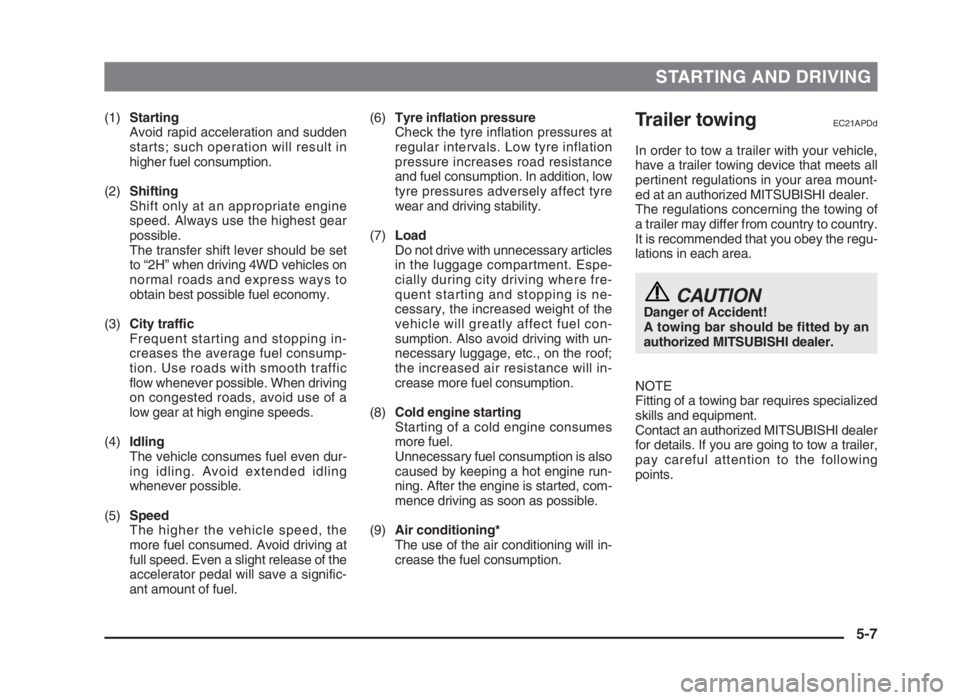
STARTING AND DRIVING
5-7
(1)Starting
Avoid rapid acceleration and sudden
starts; such operation will result in
higher fuel consumption.
(2)Shifting
Shift only at an appropriate engine
speed. Always use the highest gear
possible.
The transfer shift lever should be set
to “2H” when driving 4WD vehicles on
normal roads and express ways to
obtain best possible fuel economy.
(3)City traffic
Frequent starting and stopping in-
creases the average fuel consump-
tion. Use roads with smooth traffic
flow whenever possible. When driving
on congested roads, avoid use of a
low gear at high engine speeds.
(4)Idling
The vehicle consumes fuel even dur-
ing idling. Avoid extended idling
whenever possible.
(5)Speed
The higher the vehicle speed, the
more fuel consumed. Avoid driving at
full speed. Even a slight release of the
accelerator pedal will save a signific-
ant amount of fuel.Trailer towingEC21APDd
In order to tow a trailer with your vehicle,
have a trailer towing device that meets all
pertinent regulations in your area mount-
ed at an authorized MITSUBISHI dealer.
The regulations concerning the towing of
a trailer may differ from country to country.
It is recommended that you obey the regu-
lations in each area.
CAUTIONDanger of Accident!
A towing bar should be fitted by an
authorized MITSUBISHI dealer.
NOTE
Fitting of a towing bar requires specialized
skills and equipment.
Contact an authorized MITSUBISHI dealer
for details. If you are going to tow a trailer,
pay careful attention to the following
points.
(6)Tyre inflation pressure
Check the tyre inflation pressures at
regular intervals. Low tyre inflation
pressure increases road resistance
and fuel consumption. In addition, low
tyre pressures adversely affect tyre
wear and driving stability.
(7)Load
Do not drive with unnecessary articles
in the luggage compartment. Espe-
cially during city driving where fre-
quent starting and stopping is ne-
cessary, the increased weight of the
vehicle will greatly affect fuel con-
sumption. Also avoid driving with un-
necessary luggage, etc., on the roof;
the increased air resistance will in-
crease more fuel consumption.
(8)Cold engine starting
Starting of a cold engine consumes
more fuel.
Unnecessary fuel consumption is also
caused by keeping a hot engine run-
ning. After the engine is started, com-
mence driving as soon as possible.
(9)Air conditioning*
The use of the air conditioning will in-
crease the fuel consumption.
05engL2_240082_4 22-01-2004 13:04 Page 5-7
Page 113 of 264
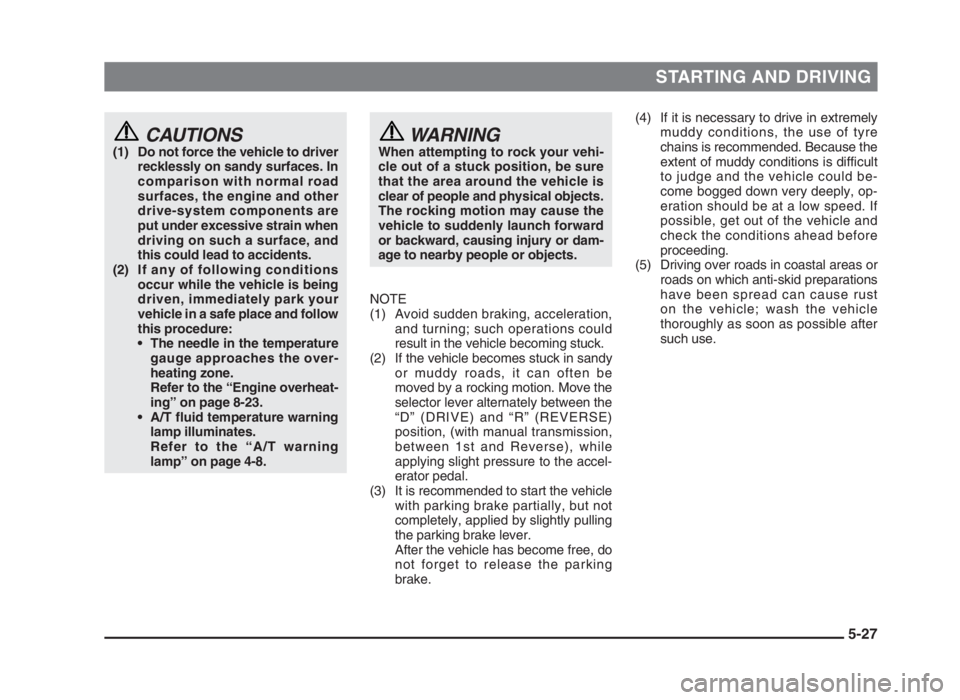
STARTING AND DRIVING
5-27
CAUTIONS(1) Do not force the vehicle to driver
recklessly on sandy surfaces. In
comparison with normal road
surfaces, the engine and other
drive-system components are
put under excessive strain when
driving on such a surface, and
this could lead to accidents.
(2) If any of following conditions
occur while the vehicle is being
driven, immediately park your
vehicle in a safe place and follow
this procedure:
• The needle in the temperature
gauge approaches the over-
heating zone.
Refer to the “Engine overheat-
ing” on page 8-23.
• A/T fluid temperature warning
lamp illuminates.
Refer to the “A/T warning
lamp” on page 4-8.
(4) If it is necessary to drive in extremely
muddy conditions, the use of tyre
chains is recommended. Because the
extent of muddy conditions is difficult
to judge and the vehicle could be-
come bogged down very deeply, op-
eration should be at a low speed. If
possible, get out of the vehicle and
check the conditions ahead before
proceeding.
(5) Driving over roads in coastal areas or
roads on which anti-skid preparations
have been spread can cause rust
on the vehicle; wash the vehicle
thoroughly as soon as possible after
such use.
WARNINGWhen attempting to rock your vehi-
cle out of a stuck position, be sure
that the area around the vehicle is
clear of people and physical objects.
The rocking motion may cause the
vehicle to suddenly launch forward
or backward, causing injury or dam-
age to nearby people or objects.
NOTE
(1) Avoid sudden braking, acceleration,
and turning; such operations could
result in the vehicle becoming stuck.
(2) If the vehicle becomes stuck in sandy
or muddy roads, it can often be
moved by a rocking motion. Move the
selector lever alternately between the
“D” (DRIVE) and “R” (REVERSE)
position, (with manual transmission,
between 1st and Reverse), while
applying slight pressure to the accel-
erator pedal.
(3) It is recommended to start the vehicle
with parking brake partially, but not
completely, applied by slightly pulling
the parking brake lever.
After the vehicle has become free, do
not forget to release the parking
brake.
05engL2_240082_4 22-01-2004 13:05 Page 5-27
Page 114 of 264
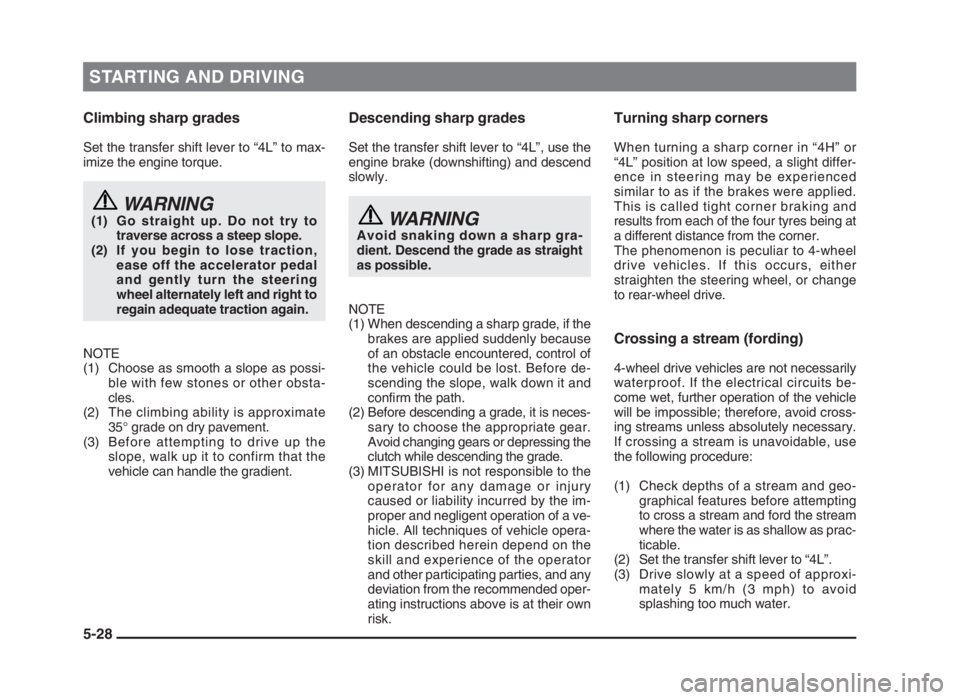
STARTING AND DRIVING
5-28 Climbing sharp grades
Set the transfer shift lever to “4L” to max-
imize the engine torque.
WARNING(1) Go straight up. Do not try to
traverse across a steep slope.
(2) If you begin to lose traction,
ease off the accelerator pedal
and gently turn the steering
wheel alternately left and right to
regain adequate traction again.
NOTE
(1) Choose as smooth a slope as possi-
ble with few stones or other obsta-
cles.
(2) The climbing ability is approximate
35° grade on dry pavement.
(3) Before attempting to drive up the
slope, walk up it to confirm that the
vehicle can handle the gradient.
Descending sharp grades
Set the transfer shift lever to “4L”, use the
engine brake (downshifting) and descend
slowly.
WARNINGAvoid snaking down a sharp gra-
dient. Descend the grade as straight
as possible.
NOTE
(1) When descending a sharp grade, if the
brakes are applied suddenly because
of an obstacle encountered, control of
the vehicle could be lost. Before de-
scending the slope, walk down it and
confirm the path.
(2) Before descending a grade, it is neces-
sary to choose the appropriate gear.
Avoid changing gears or depressing the
clutch while descending the grade.
(3) MITSUBISHI is not responsible to the
operator for any damage or injury
caused or liability incurred by the im-
proper and negligent operation of a ve-
hicle. All techniques of vehicle opera-
tion described herein depend on the
skill and experience of the operator
and other participating parties, and any
deviation from the recommended oper-
ating instructions above is at their own
risk.
Turning sharp corners
When turning a sharp corner in “4H” or
“4L” position at low speed, a slight differ-
ence in steering may be experienced
similar to as if the brakes were applied.
This is called tight corner braking and
results from each of the four tyres being at
a different distance from the corner.
The phenomenon is peculiar to 4-wheel
drive vehicles. If this occurs, either
straighten the steering wheel, or change
to rear-wheel drive.
Crossing a stream (fording)
4-wheel drive vehicles are not necessarily
waterproof. If the electrical circuits be-
come wet, further operation of the vehicle
will be impossible; therefore, avoid cross-
ing streams unless absolutely necessary.
If crossing a stream is unavoidable, use
the following procedure:
(1) Check depths of a stream and geo-
graphical features before attempting
to cross a stream and ford the stream
where the water is as shallow as prac-
ticable.
(2) Set the transfer shift lever to “4L”.
(3) Drive slowly at a speed of approxi-
mately 5 km/h (3 mph) to avoid
splashing too much water.
05engL2_240082_4 22-01-2004 13:05 Page 5-28
Page 115 of 264
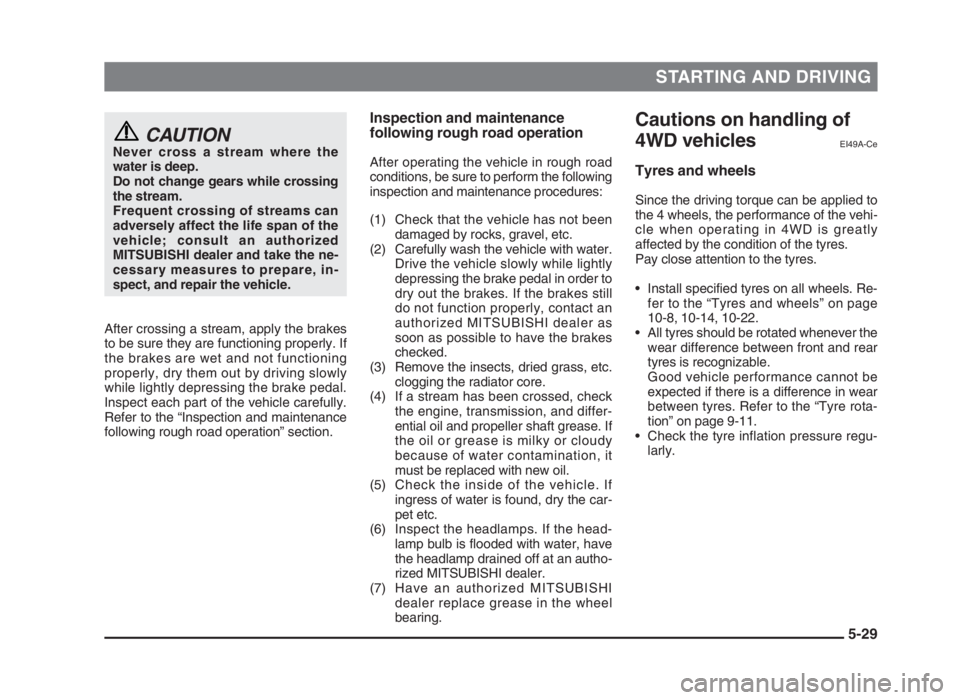
STARTING AND DRIVING
5-29
CAUTIONNever cross a stream where the
water is deep.
Do not change gears while crossing
the stream.
Frequent crossing of streams can
adversely affect the life span of the
vehicle; consult an authorized
MITSUBISHI dealer and take the ne-
cessary measures to prepare, in-
spect, and repair the vehicle.
After crossing a stream, apply the brakes
to be sure they are functioning properly. If
the brakes are wet and not functioning
properly, dry them out by driving slowly
while lightly depressing the brake pedal.
Inspect each part of the vehicle carefully.
Refer to the “Inspection and maintenance
following rough road operation” section.
Cautions on handling of
4WD vehicles
EI49A-Ce
Tyres and wheels
Since the driving torque can be applied to
the 4 wheels, the performance of the vehi-
cle when operating in 4WD is greatly
affected by the condition of the tyres.
Pay close attention to the tyres.
• Install specified tyres on all wheels. Re-
fer to the “Tyres and wheels” on page
10-8, 10-14, 10-22.
• All tyres should be rotated whenever the
wear difference between front and rear
tyres is recognizable.
Good vehicle performance cannot be
expected if there is a difference in wear
between tyres. Refer to the “Tyre rota-
tion” on page 9-11.
• Check the tyre inflation pressure regu-
larly.
Inspection and maintenance
following rough road operation
After operating the vehicle in rough road
conditions, be sure to perform the following
inspection and maintenance procedures:
(1) Check that the vehicle has not been
damaged by rocks, gravel, etc.
(2) Carefully wash the vehicle with water.
Drive the vehicle slowly while lightly
depressing the brake pedal in order to
dry out the brakes. If the brakes still
do not function properly, contact an
authorized MITSUBISHI dealer as
soon as possible to have the brakes
checked.
(3) Remove the insects, dried grass, etc.
clogging the radiator core.
(4) If a stream has been crossed, check
the engine, transmission, and differ-
ential oil and propeller shaft grease. If
the oil or grease is milky or cloudy
because of water contamination, it
must be replaced with new oil.
(5) Check the inside of the vehicle. If
ingress of water is found, dry the car-
pet etc.
(6) Inspect the headlamps. If the head-
lamp bulb is flooded with water, have
the headlamp drained off at an autho-
rized MITSUBISHI dealer.
(7) Have an authorized MITSUBISHI
dealer replace grease in the wheel
bearing.
05engL2_240082_4 22-01-2004 13:05 Page 5-29
Page 118 of 264
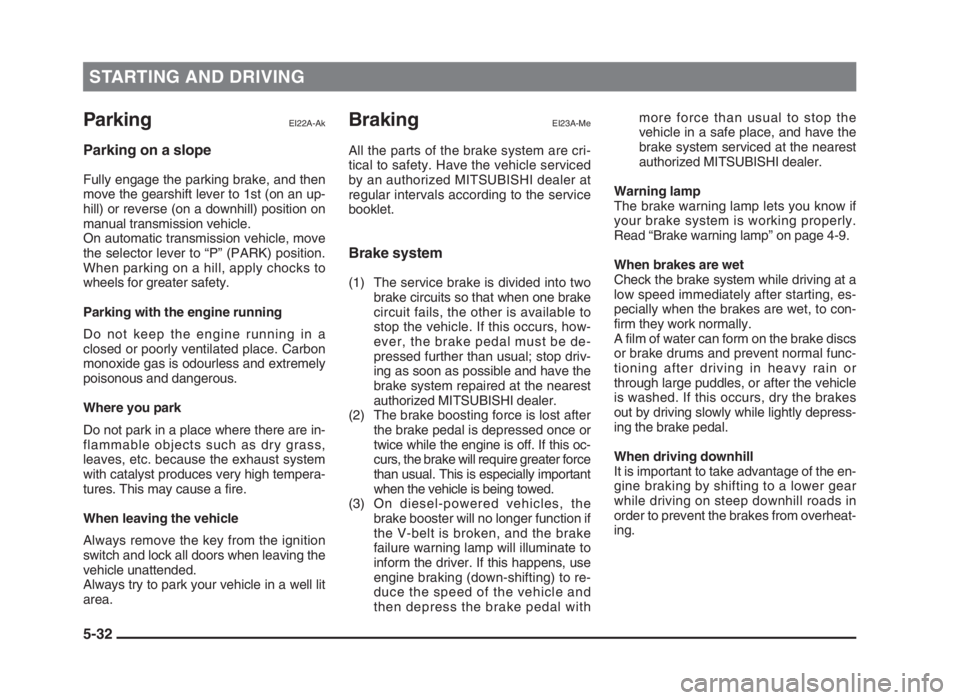
STARTING AND DRIVING
5-32
ParkingEI22A-Ak
Parking on a slope
Fully engage the parking brake, and then
move the gearshift lever to 1st (on an up-
hill) or reverse (on a downhill) position on
manual transmission vehicle.
On automatic transmission vehicle, move
the selector lever to “P” (PARK) position.
When parking on a hill, apply chocks to
wheels for greater safety.
Parking with the engine running
Do not keep the engine running in a
closed or poorly ventilated place. Carbon
monoxide gas is odourless and extremely
poisonous and dangerous.
Where you park
Do not park in a place where there are in-
flammable objects such as dry grass,
leaves, etc. because the exhaust system
with catalyst produces very high tempera-
tures. This may cause a fire.
When leaving the vehicle
Always remove the key from the ignition
switch and lock all doors when leaving the
vehicle unattended.
Always try to park your vehicle in a well lit
area.
BrakingEI23A-Me
All the parts of the brake system are cri-
tical to safety. Have the vehicle serviced
by an authorized MITSUBISHI dealer at
regular intervals according to the service
booklet.
Brake system
(1) The service brake is divided into two
brake circuits so that when one brake
circuit fails, the other is available to
stop the vehicle. If this occurs, how-
ever, the brake pedal must be de-
pressed further than usual; stop driv-
ing as soon as possible and have the
brake system repaired at the nearest
authorized MITSUBISHI dealer.
(2) The brake boosting force is lost after
the brake pedal is depressed once or
twice while the engine is off. If this oc-
curs, the brake will require greater force
than usual. This is especially important
when the vehicle is being towed.
(3) On diesel-powered vehicles, the
brake booster will no longer function if
the V-belt is broken, and the brake
failure warning lamp will illuminate to
inform the driver. If this happens, use
engine braking (down-shifting) to re-
duce the speed of the vehicle and
then depress the brake pedal withmore force than usual to stop the
vehicle in a safe place, and have the
brake system serviced at the nearest
authorized MITSUBISHI dealer.
Warning lamp
The brake warning lamp lets you know if
your brake system is working properly.
Read “Brake warning lamp” on page 4-9.
When brakes are wet
Check the brake system while driving at a
low speed immediately after starting, es-
pecially when the brakes are wet, to con-
firm they work normally.
A film of water can form on the brake discs
or brake drums and prevent normal func-
tioning after driving in heavy rain or
through large puddles, or after the vehicle
is washed. If this occurs, dry the brakes
out by driving slowly while lightly depress-
ing the brake pedal.
When driving downhill
It is important to take advantage of the en-
gine braking by shifting to a lower gear
while driving on steep downhill roads in
order to prevent the brakes from overheat-
ing.
05engL2_240082_4 22-01-2004 13:05 Page 5-32
Page 121 of 264
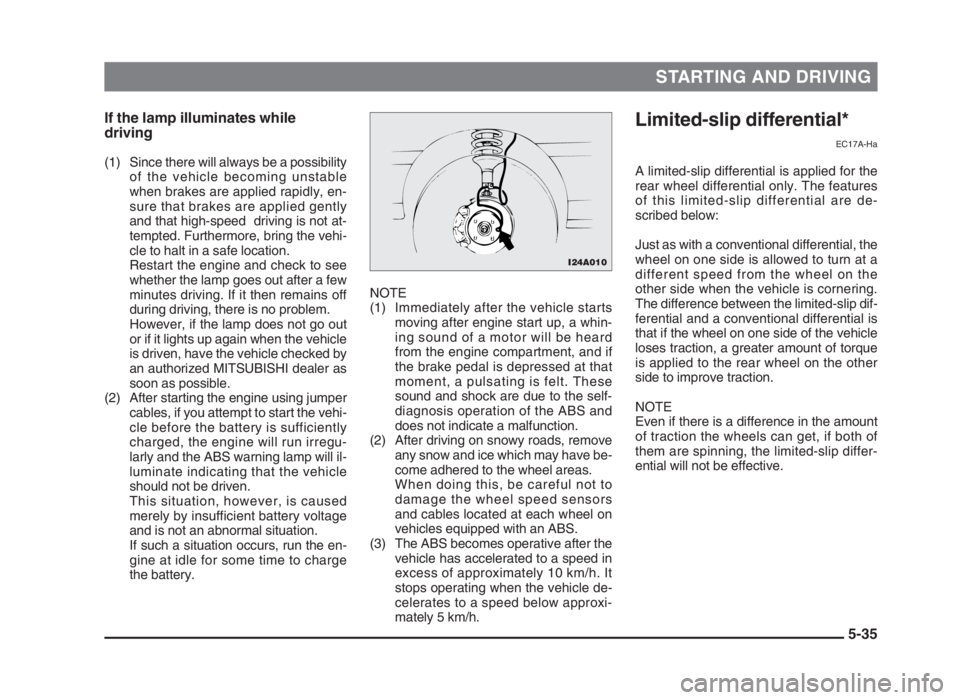
STARTING AND DRIVING
5-35 If the lamp illuminates while
driving
(1) Since there will always be a possibility
of the vehicle becoming unstable
when brakes are applied rapidly, en-
sure that brakes are applied gently
and that high-speed driving is not at-
tempted. Furthermore, bring the vehi-
cle to halt in a safe location.
Restart the engine and check to see
whether the lamp goes out after a few
minutes driving. If it then remains off
during driving, there is no problem.
However, if the lamp does not go out
or if it lights up again when the vehicle
is driven, have the vehicle checked by
an authorized MITSUBISHI dealer as
soon as possible.
(2) After starting the engine using jumper
cables, if you attempt to start the vehi-
cle before the battery is sufficiently
charged, the engine will run irregu-
larly and the ABS warning lamp will il-
luminate indicating that the vehicle
should not be driven.
This situation, however, is caused
merely by insufficient battery voltage
and is not an abnormal situation.
If such a situation occurs, run the en-
gine at idle for some time to charge
the battery.
Limited-slip differential*
EC17A-Ha
A limited-slip differential is applied for the
rear wheel differential only. The features
of this limited-slip differential are de-
scribed below:
Just as with a conventional differential, the
wheel on one side is allowed to turn at a
different speed from the wheel on the
other side when the vehicle is cornering.
The difference between the limited-slip dif-
ferential and a conventional differential is
that if the wheel on one side of the vehicle
loses traction, a greater amount of torque
is applied to the rear wheel on the other
side to improve traction.
NOTE
Even if there is a difference in the amount
of traction the wheels can get, if both of
them are spinning, the limited-slip differ-
ential will not be effective. NOTE
(1) Immediately after the vehicle starts
moving after engine start up, a whin-
ing sound of a motor will be heard
from the engine compartment, and if
the brake pedal is depressed at that
moment, a pulsating is felt. These
sound and shock are due to the self-
diagnosis operation of the ABS and
does not indicate a malfunction.
(2) After driving on snowy roads, remove
any snow and ice which may have be-
come adhered to the wheel areas.
When doing this, be careful not to
damage the wheel speed sensors
and cables located at each wheel on
vehicles equipped with an ABS.
(3) The ABS becomes operative after the
vehicle has accelerated to a speed in
excess of approximately 10 km/h. It
stops operating when the vehicle de-
celerates to a speed below approxi-
mately 5 km/h.
I24A010
05engL2_240082_4 22-01-2004 13:05 Page 5-35
Page 123 of 264
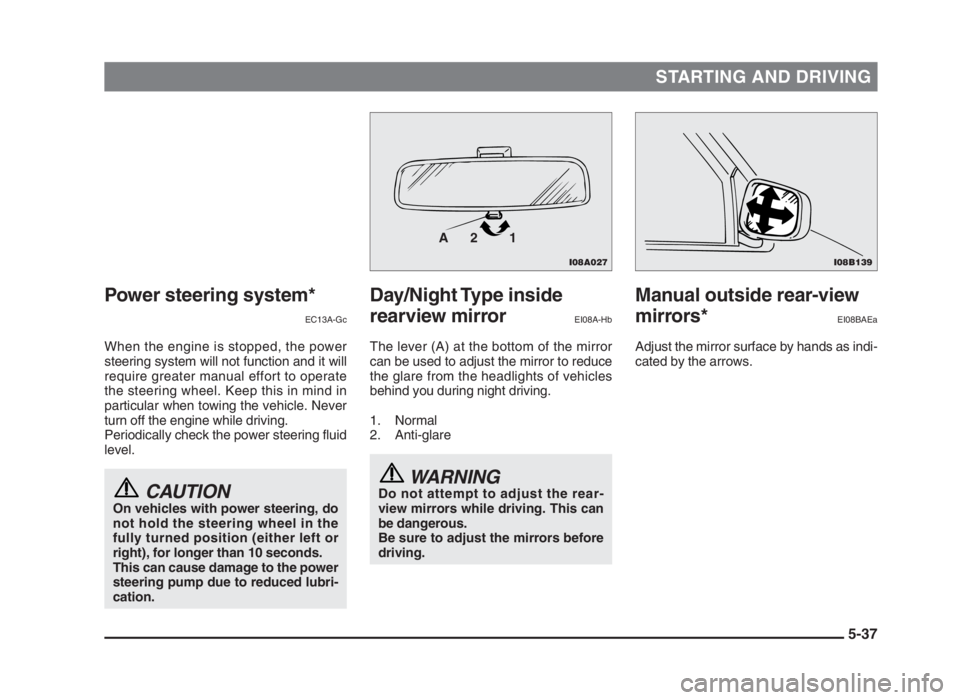
STARTING AND DRIVING
5-37
Power steering system*
EC13A-Gc
When the engine is stopped, the power
steering system will not function and it will
require greater manual effort to operate
the steering wheel. Keep this in mind in
particular when towing the vehicle. Never
turn off the engine while driving.
Periodically check the power steering fluid
level.
CAUTIONOn vehicles with power steering, do
not hold the steering wheel in the
fully turned position (either left or
right), for longer than 10 seconds.
This can cause damage to the power
steering pump due to reduced lubri-
cation.
Manual outside rear-view
mirrors*
EI08BAEa
Adjust the mirror surface by hands as indi-
cated by the arrows.
Day/Night Type inside
rearview mirror
EI08A-Hb
The lever (A) at the bottom of the mirror
can be used to adjust the mirror to reduce
the glare from the headlights of vehicles
behind you during night driving.
1. Normal
2. Anti-glare
WARNINGDo not attempt to adjust the rear-
view mirrors while driving. This can
be dangerous.
Be sure to adjust the mirrors before
driving.
I08B139I08A027
1 2 A
05engL2_240082_4 22-01-2004 13:05 Page 5-37
Page 219 of 264
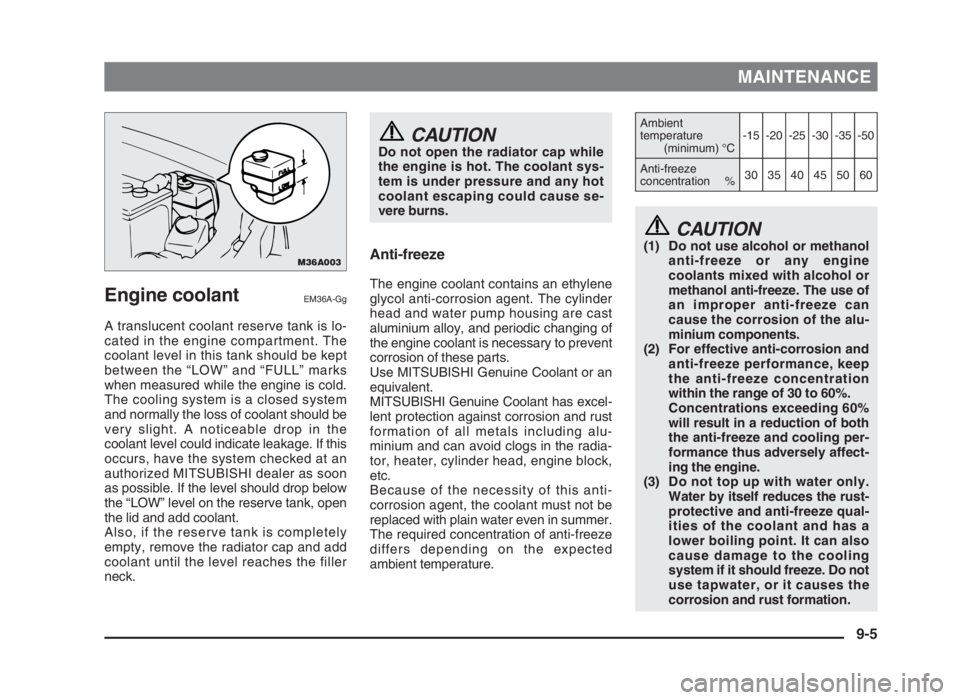
Engine coolantEM36A-Gg
A translucent coolant reserve tank is lo-
cated in the engine compartment. The
coolant level in this tank should be kept
between the “LOW” and “FULL” marks
when measured while the engine is cold.
The cooling system is a closed system
and normally the loss of coolant should be
very slight. A noticeable drop in the
coolant level could indicate leakage. If this
occurs, have the system checked at an
authorized MITSUBISHI dealer as soon
as possible. If the level should drop below
the “LOW” level on the reserve tank, open
the lid and add coolant.
Also, if the reserve tank is completely
empty, remove the radiator cap and add
coolant until the level reaches the filler
neck.
MAINTENANCE
CAUTION(1) Do not use alcohol or methanol
anti-freeze or any engine
coolants mixed with alcohol or
methanol anti-freeze. The use of
an improper anti-freeze can
cause the corrosion of the alu-
minium components.
(2) For effective anti-corrosion and
anti-freeze performance, keep
the anti-freeze concentration
within the range of 30 to 60%.
Concentrations exceeding 60%
will result in a reduction of both
the anti-freeze and cooling per-
formance thus adversely affect-
ing the engine.
(3) Do not top up with water only.
Water by itself reduces the rust-
protective and anti-freeze qual-
ities of the coolant and has a
lower boiling point. It can also
cause damage to the cooling
system if it should freeze. Do not
use tapwater, or it causes the
corrosion and rust formation.
CAUTIONDo not open the radiator cap while
the engine is hot. The coolant sys-
tem is under pressure and any hot
coolant escaping could cause se-
vere burns.
Anti-freeze
The engine coolant contains an ethylene
glycol anti-corrosion agent. The cylinder
head and water pump housing are cast
aluminium alloy, and periodic changing of
the engine coolant is necessary to prevent
corrosion of these parts.
Use MITSUBISHI Genuine Coolant or an
equivalent.
MITSUBISHI Genuine Coolant has excel-
lent protection against corrosion and rust
formation of all metals including alu-
minium and can avoid clogs in the radia-
tor, heater, cylinder head, engine block,
etc.
Because of the necessity of this anti-
corrosion agent, the coolant must not be
replaced with plain water even in summer.
The required concentration of anti-freeze
differs depending on the expected
ambient temperature.
9-5
M36A003
Ambient
temperature
(minimum) °C-15-20-25-30-35-50
Anti-freeze
concentration %303540455060
09engL2_240082_4 22-01-2004 13:12 Page 9-5